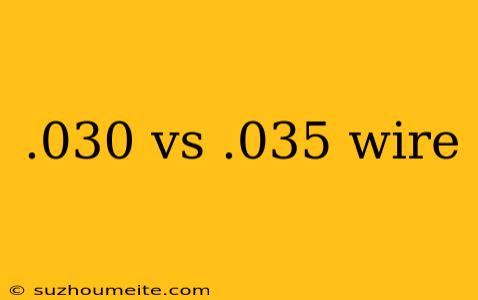.030 vs .035 Wire: Which One to Choose for Your Welding Needs
When it comes to welding, choosing the right wire is crucial to achieve high-quality welds. Two of the most common wire sizes used in welding are .030 and .035. While both wires are popular among welders, they have distinct differences that make them suitable for specific applications. In this article, we'll delve into the differences between .030 and .035 wire to help you decide which one is best for your welding needs.
.030 Wire: The Thinner Option
Advantages
- Easier to feed: The .030 wire is thinner and more flexible, making it easier to feed through the gun and into the welding area.
- Less heat input: The smaller diameter of the wire requires less heat input, resulting in a smaller weld pool and reduced heat distortion.
- Better for thin metals: The .030 wire is ideal for welding thin metals (1/8 inch or less) as it produces a smaller weld pool that won't melt through the metal.
Disadvantages
- Less penetration: The thinner wire has less penetration, which can lead to incomplete fusion and porosity in the weld.
- More prone to burn-through: The smaller wire can burn through thin metals if the heat input is too high.
.035 Wire: The Thicker Option
Advantages
- More penetration: The thicker .035 wire has better penetration, resulting in stronger welds with less porosity.
- Better for thicker metals: The .035 wire is suitable for welding thicker metals (1/4 inch or more) as it produces a larger weld pool that can fill gaps and provide a stronger bond.
- Easier to use with rusty or dirty metals: The thicker wire is more forgiving when working with rusty or dirty metals, as it can push through the contaminants more easily.
Disadvantages
- Harder to feed: The thicker wire is stiffer and more difficult to feed through the gun, especially in tight spaces.
- More heat input required: The larger wire requires more heat input, which can lead to more heat distortion and warping of the metal.
Choosing the Right Wire for Your Project
When deciding between .030 and .035 wire, consider the following factors:
- Metal thickness: Use .030 wire for thin metals (1/8 inch or less) and .035 wire for thicker metals (1/4 inch or more).
- Welding position: Use .030 wire for out-of-position welding (e.g., overhead or vertical) and .035 wire for flat and horizontal welding.
- Desired weld quality: Use .035 wire for high-strength welds and .030 wire for cosmetic welds.
Conclusion
In conclusion, both .030 and .035 wire have their advantages and disadvantages. Choosing the right wire for your welding needs depends on the metal thickness, welding position, and desired weld quality. By understanding the differences between these two wire sizes, you can achieve high-quality welds and improve your overall welding experience.
